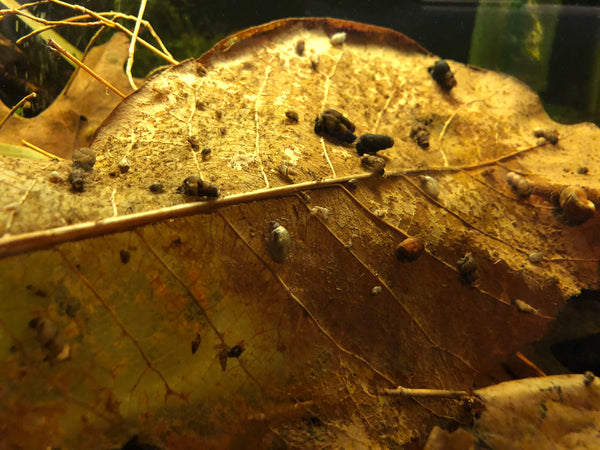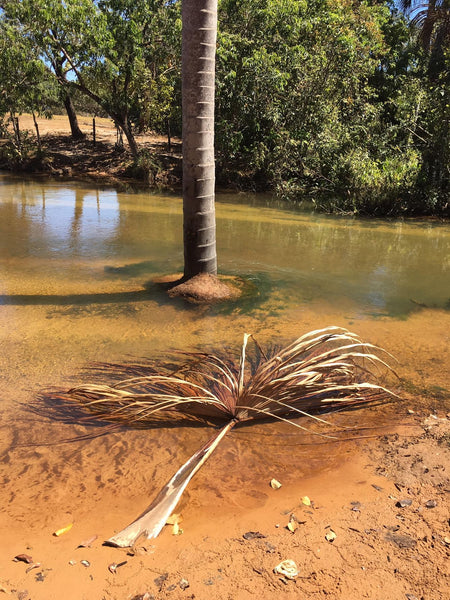- Continue Shopping
- Your Cart is Empty
In celebration of the ephemeral...
I've said it before, and I'll say it again: There is remarkable beauty in the ephemeral.
Botanicals are most definitely ephemeral in nature, having finite "life spans" when submerged. They soften, recruit fungal growths and biofilms on their surfaces, and slowly begin their inexorable march towards decomposition and physical breakdown.

We value this. Indeed, we celebrate this.
To understand and appreciate this is key to grasping the philosophy behind the botanical-style aquarium.
Those of us who play with botanical-style blackwater/brackish aquariums find out in the earliest stages that each aquarium moves at its own pace. Each one establishes itself, evolves, and matures differently than any other one. There is a real "pace", a process- to what occurs when they are utilized in our aquariums.
And a good part of it is dictated by the natural degradation, change, and decomposition of the materials we utilize in our tanks. From the minute you prepare a leaf, seed pod, stem, or other botanical for use in the aquarium, it begins to soften and break down.
It's definitely the embodiment of "ephemeral."

The processes of hot water steeping, boiling, or prolonged soaking start to soften the tissues of the leaves or seed pods, release bound-up surface pollutants, and begin the gradual, inevitable, and irreversible process of breaking them down, at a pace, which nature determines.
As botanical materials break down, more and more compounds (tannins, humic substances, lignin, bound-up organic matter) begin leaching into the water column in your aquarium, influencing the water chemistry and overall environment.
They "power" the biome of the aquarium, providing sustenance to numerous organisms which reside there.

In the wild, there are numerous aquatic habitats which are ephemeral in nature- lasting only for a season or two before drying up; only to begin the cycle anew the following year.
An example is the "vernal pool", a surprisingly rich, and very interesting habitat.
Vernal pools are classified by ecologists as a type of wetland, although they are, as their name implies, temporary aquatic habitats. Certain fishes, such as annual killifish, have evolved to adapt and thrive in these environments over eons. This, of course, makes these unique aquatic ecosystems all the more fascinating to us as tropical fish hobbyists!

Understanding this type of habitat has lots of implications for creating very cool biotope-inspired aquariums.
And why not make 'em for killifish?
And maybe, just maybe- they might help make killifish, and the killifish hobby, more interesting, appealing, and relevant to a new group of hobbyists- long a topic of concern among the killie-keeping "establishment!"
A big win, if you ask me!
And it can start with considering these pools another ephemeral habitats which these fishes reside in.

These pools are surprisingly productive, with significant crustacean and insect life- a truly remarkableabundance of life- which helps sustain the fishes which reside in the vernal pools. Most Nothobranchius species are what ecologists classify as "generalized carnivores", feeding on a range of planktonic and benthic invertebrates and insects found in these habitats.

Typical vernal pools in the tropical locales mentioned above are dry for at least part of the year, and typically, but not always, fill with water during seasonal rain/flooding events. Some of these pools may stay partially filled with water during a given year- or longer- but all vernal pools dry up periodically. Sometimes, these pools empty and fill several times during the wet season. Movement of water between vernal pools also occurs.
Vernal pools are typically associated with plains or grasslands, and are typically small bodies of water- often just a few meters wide. The origin of the name, "vernal" refers to the Spring season. And, this makes a lot of sense, because most of these ephemeral habitats are at their maximum water depth during the Spring!

After studying these vernal pools for some time now, I can't help but be drawn to the idea we've played with in our "Urban Igapo" tanks- utilizing soil/sediment mixes and playing with "seasonal" cycles of inundation and desiccation, which simulate, to the most realistic extent possible, the cycles of the vernal pools, grasslands, and flooded forests of the tropical world.

Vernal pools and flooded forests are perhaps the ultimate expression of the close relationship between the terrestrial and aquatic habitats. Decomposition, accumulation of epiphytic growth, and colonization of various life forms is continuous and impactful.

Every terrestrial botanical eventually breaks down completely underwater, imparting organics, tannins, lignin, and other compounds into the water. It could take a few weeks, a month, or even years. However, complete breakdown eventually occurs.
When it occurs is dictated entirely by Nature, of course.
That, to me, is the charm of what we do as aquarists who embrace this. We celebrate the process. We celebrate the process because we understand how it positively impacts the environment of our aquariums and the fishes which reside in them.

Those of us who look at Nature as it is, and choose to embrace it in our tanks, instead of some sanitized, stylized representation, find true beauty in this ephemeral characteristic that botanicals bring. Just like in the wild, the way terrestrial materials break down and "devolve" under water is fascinating, biologically useful...and beautiful.

Some hobbyists find the fact that we allow materials to break down in our tanks like they do in Nature to be undisciplined, even "messy."
However, I've learned what many of you have over your fish keeping careers: The so-called "mess" is- or often leads to -something beautiful, permanent, and utterly engrossing. So the term "mess", as we might commonly use it, should not be viewed as negative. It's more of a "transition", IMHO!
"Mess" is actually a vehicle to propel us in different aquascaping/experimental directions. It actually is the embodiment of Amano's wabi-sabi philosophy, which embraces the transience of nature- and celebrates it. It appreciates and understands the beauty in the ephemeral aspects of Nature.

It requires some study, appreciation, and yes- mental shifts.
Mental shifts which allow us to appreciate the process in Nature as much as we do in our tanks. Somehow, I think that seeing these processes play out in the wild aquatic habitats gives some of us "permission" to allow it to happen in our aquariums!
We can take comfort in seeing that these habitats thrive despite what appears to be contrary to our hobby interpretation of how we think they're "supposed" to look and function.

And that's okay. It's part of the game. It's how Nature teaches us. And what Nature teaches us is, in my opinion, every bit as valuable- if not more so- than the latest aquascape contest winner who's "diorama 'scape" is all the rage on Instagram, or wherever.
Nature plays by her own rules, developed over eons. When we accept here rule, embrace her aesthetics...and make a mental shift to something that the rest of the world might call messy- we can truly appreciate it's real beauty.

There is much to learn from this process.
And the patience, understanding, and knowledge that we gain from observing Nature do her thing in our tanks is a priceless experience.
Nothing lasts forever, but the enjoyment of the process lasts a lifetime.
Todays quick thought.
Stay curious. Stay reflective. Stay thoughtful. Stay observant. Stay enthralled...
And Stay Wet.
Scott Fellman
Tannin Aquatics







Scott Fellman
Author